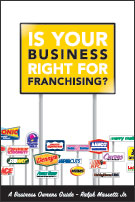|
Call Us Today
5551231234 |
||
|
Contact Us by Email |
||
| Request More Information |

Buy a copy of our CEO's book "Is Your Business Right For Franchising?" on Amazon today.
International Franchise Association (IFA)
Supplier Forum Member

How to Grow a Chain That's Already Everywhere
(Business 2.0) March 2005 Issue -- By Bridget Finn
It took McDonald's 25 years to open 6,000 outlets; Gary Heavin, founder and CEO of the no-frills, for-women-only fitness chain Curves, achieved that milestone in less than eight years, making Curves the fastest-growing franchise operation in history. Last August the privately owned company—which targets overweight women who shun mainstream gyms—surpassed 8,000 locations, and Heavin says it posted an $80 million profit on franchisee revenues of more than $1 billion in 2004. Which poses the same conundrum faced by explosive-growth chains from Starbucks to Krispy Kreme: How do you boost revenue once you've saturated the market? The answer is getting people to spend more at existing stores. Here's how Heavin plans to do that with the millions of exercise-phobic women he has already persuaded to work out.
When I sold my first franchise in 1995, I learned that fast-food franchisees paid 6 percent of revenues each month, but that didn't make sense to me: Why should franchisees that make the most money have to pay me more? Instead, I charged $20,000 to open a club and a flat monthly fee of $395. Most of my franchisees were profitable in 90 days and were shouting from the rooftops about their quick success.
With PR like that, we expanded in small towns and eventually to cities. But now even metro areas are saturated: There are 100 Curves in the greater Houston area, for example, and in some parts of Manhattan, there's a Curves on every other block. To drive sales, we have to do more with the Curves brand. We ran a $16 million advertising campaign for the first time in 2003, and last March we launched a magazine. My fitness and dieting book made the New York Times best-seller list in 2004.
We also have to launch new services. The purpose of the book was to get people associating the Curves name with weight management. Last spring we launched our nationwide weight management program, for which we charge $59 for a six-week class. My aim is that in the next few years America's most successful diet centers will be found at Curves.
Remarkable Growth Curves
Annual sales growth: 58%
Number of new locations per year: 1,570
Number of new members per year: 731,200
(Average 1999-2004, Source: Curves)
With more franchisee demand for fewer potential new locations, I've also raised the cost of opening a club to $30,000, and new owners now pay 5 percent of revenues, capped at $795. That lets me finance research for future offerings. For example, health insurance companies might one day send us high-risk customers, and with exercise and diet advice we could reduce their medical costs.
In earlier attempts at running gyms, I expanded quickly, ran out of money, and was forced out of business. With Curves, now that we've gotten into profitable locations, the focus is shifting from expansion to innovation. An innovator looks at the same thing everyone else looks at and sees something different. No one serves women the way we do. Now we have to do it even better.

